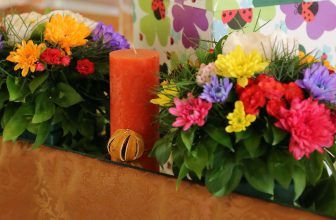How to Make Decor Books
Decorative books have surged in popularity as a versatile element in interior design. These aesthetically appealing books are more than just reading material; they serve as a sophisticated decor feature that adds personality and warmth to any space.
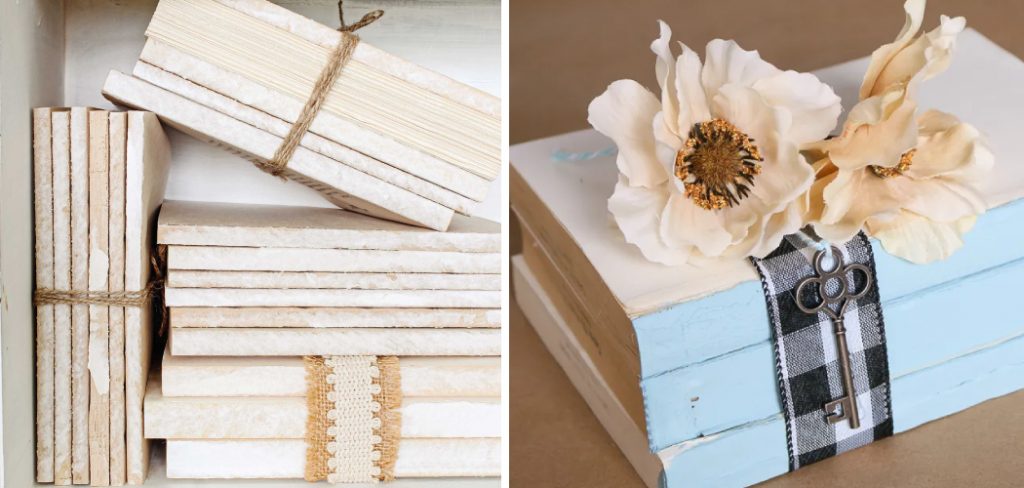
The importance of decor books in interior design cannot be overstated. Whether artfully stacked on coffee tables or arranged on bookshelves, they contribute to the ambiance of a room, reflecting the homeowner’s style and interests.
The DIY approach to creating decor books has opened up countless possibilities for customization and creativity. Learning how to make decor books allows individuals to transform ordinary books into personalized pieces of art.
It’s a process that beautifies your space and offers a fulfilling experience of crafting something unique with your own hands. From selecting the perfect book to applying the final touches, each step is an opportunity to infuse personal style and creativity into your home decor. This guide will explore various techniques and ideas to inspire your decor book projects, ensuring you have all the knowledge needed to start this rewarding DIY adventure.
Gathering Materials and Tools
The first step in creating your decor books is gathering all the necessary materials and tools. This preparatory phase is crucial in ensuring a smooth and enjoyable crafting process.
A. Selection of Old or Unused Books
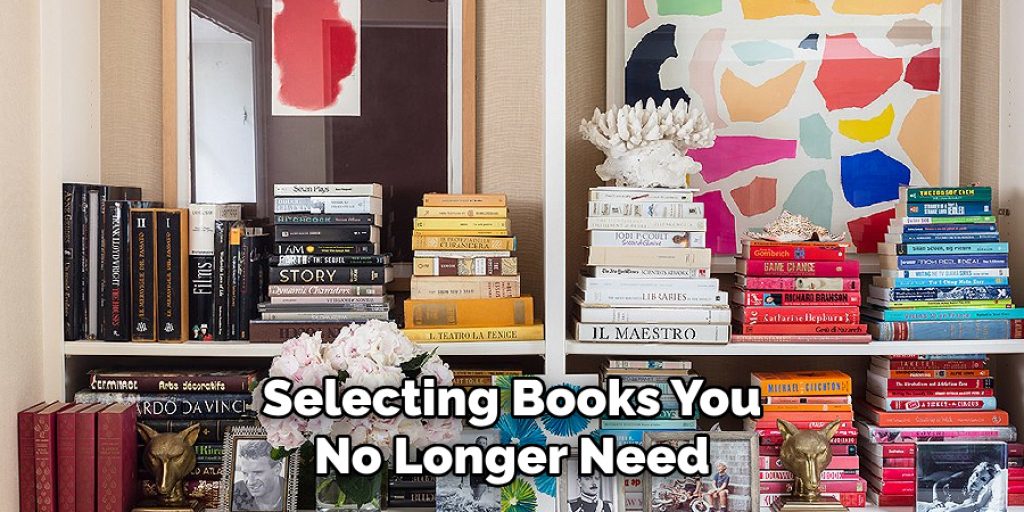
Start by selecting books you no longer need or ones you’ve picked up from a thrift store specifically for this purpose. The book’s size, color, and texture can all play a part in the final aesthetic of your decor book, so choose wisely. Remember that hardcover books are generally more durable and better suited for decorating.
B. Choosing Decorative Paper or Fabric
The choice of decorative paper or fabric will define the look of your finished book. Whether you opt for elegant, patterned paper, textured fabric, or even recycled materials, ensure it resonates with your intended decor style. Consider the color scheme of the room where the book will be displayed to ensure cohesion.
C. Additional Materials such as Glue, Scissors, and Paint
Finally, gather your crafting essentials. High-quality craft glue or Mod Podge is necessary for adhering paper or fabric to the book cover. Scissors will be used to cut materials to size, and paint can be used to add color to the book edges or create designs directly on the cover. Optional materials like brushes, ribbons, or charms can also be collected if your design calls for them.
Collecting these materials in advance will streamline your crafting process, making it more enjoyable and efficient. With everything at hand, you’re now ready to transform an ordinary book into a stunning piece of decor.
Preparing the Books for Decoration
Before the actual decoration begins, preparing your books is a crucial step to ensure they are in the best condition for crafting. This preparation phase sets the foundation for transforming from a plain book to a decorative masterpiece.
A. Cleaning and Repairing Old Books

Start by gently cleaning the cover and edges of your books with a soft, dry cloth to remove any dust or grime. If you encounter stubborn spots, a slightly damp cloth can be used, but ensure the book is completely dry before proceeding. A bit of craft glue can reinforce these areas for books with loose bindings or torn pages. Be careful to repair any damages to maintain the book’s integrity while making it sturdy enough for decoration.
B. Removing Dust Jackets or Unwanted Elements
Most hardcover books come with dust jackets that might not align with your decorative vision. Carefully remove these jackets to reveal the book’s actual cover, which is often more suitable for decor purposes. Additionally, inspect the book for any stickers or labels that could detract from its appearance; these can usually be peeled off slowly or removed with a gentle application of a solvent like Goo Gone, followed by a clean wipe.
C. Ensuring the Books are Suitable for Decoration
Finally, evaluate the suitability of each book for your project. Consider the book’s size, color, and overall condition. Books that are too worn out might not hold up well to further embellishment, while those in better shape can be transformed more effectively. This step ensures that your effort and materials are invested in books yielding the most aesthetically pleasing and durable decor pieces.

By meticulously preparing your books, you ensure that they are primed for the creative process ahead. This groundwork enhances the final look of your decor books and contributes to their longevity as part of your home’s interior design.
The section you’ve referred to has already been provided in the existing content. Given this, I will continue with the next section of the document instead.
How to Make Decor Books: Personalizing and Decorating the Books
Once your books are prepared, the next step is to breathe new life into them through personalization and decoration. This phase allows for immense creativity and personal expression, ensuring your decor books truly reflect your style and add distinct character to your space.
A. Applying Decorative Paper or Fabric
Begin by measuring and cutting your chosen decorative paper or fabric to size, ensuring it fully covers the book cover or the specific area you intend to decorate. Apply a thin, even layer of craft glue or Mod Podge to the surface of the book cover. Carefully place the paper or fabric onto the glued area, smoothing out any bubbles or wrinkles with your fingers or a straight edge. Allow it to dry completely before moving on to further embellishments.
B. Adding Embellishments and Personal Touches

This is your opportunity to make each book uniquely yours. Use ribbons, buttons, stencils, or paint to add patterns, textures, or personalized elements to your books. For example, painting the book edges or adding a stencil design can give a modern twist to an otherwise simple book. Gluing charms or vintage finds to the spine, or cover can add a three-dimensional aspect to your decor book, making it stand out.
C. Sealing and Protecting the Decoration
Once you are satisfied with your decoration, apply a final layer of Mod Podge over the surface to seal and protect your work. This step is particularly important if you’ve used paper decorations, as it will prevent peeling and wear over time. Ensure the sealant is applied evenly and sparingly, as too much can cause paper or fabric to wrinkle. Once dry, your books are ready to be styled and displayed.
By following these steps, you have now transformed ordinary books into personalized decor pieces that enhance your space’s aesthetics and carry a piece of your creativity and flair. Whether displayed on a coffee table, used as bookshelf fillers, or gifted to someone special, these decor books are a testament to the beauty of handmade and customized decor.
How to Make Decor Books: Creating Textured and Patterned Covers
Transforming plain book covers into captivating pieces of art with textures and patterns can significantly elevate your home décor. This section focuses on three innovative approaches to achieve stunning visual and tactile effects on book covers.
A. Using Stencils for Intricate Designs

Stenciling is a fantastic way to add precise, intricate designs to your book covers without needing advanced artistic skills. Begin by selecting stencils that complement your home’s aesthetic or hold personal significance. Secure the stencil onto the book cover using painter’s tape to prevent it from shifting.
Utilize a sponge or stencil brush to dab acrylic paint or ink over the stencil, applying a thin layer to avoid bleeding under the stencil edges. Once satisfied, gently remove the stencil to reveal the design. This technique allows for creating uniform patterns across multiple books or adding sophisticated decorative elements to individual pieces.
B. Applying Decoupage or Collage Techniques
Decoupage and collage techniques offer a playful and creative way to cover books with a mix of paper materials, such as magazines, wrapping paper, or old maps. Start by tearing or cutting your selected paper into pieces. Arrange the pieces on the book cover before attaching them to visualize the final look.
Using a brush, apply a layer of mod podge to the book cover, place the paper pieces on top, and then seal everything with another layer of mod podge. This method creates a unique, layered effect that can range from elegant to whimsical, depending on the materials used.
C. Incorporating Fabric or Textured Materials
For a luxurious and tactile experience, consider covering books with fabric or other textured materials like burlap or leather. Measure and cut the fabric, leaving enough extra to fold over the book edges. Apply fabric glue or Mod Podge to the book cover, then carefully position the fabric, smoothing out any wrinkles or bubbles. Fold the excess material over the cover edges and glue it down for a neat finish. Fabrics with distinctive textures or patterns can add depth and interest to your book décor, making each piece a standout element in your room.

You can transform ordinary books into bespoke décor items by incorporating these textured and patterned cover techniques. Whether opting for the elegance of stenciled designs, the eclectic charm of decoupage and collage, or the tactile allure of fabric-covered books, each method offers a unique way to personalize and enhance your home décor. Through creativity and experimentation, your book collection can become a curated display of artful designs and textures.
How to Make Decor Books: Personalizing Decor Books
In the realm of home decoration, personalizing decor books allows homeowners to infuse their unique essence and memories into their living spaces. Here are some creative ways to add personalized touches to your decor books, enhancing their sentimental value and visual appeal.
A. Adding Personalized Touches like Monograms
Monograms add a touch of elegance and personal identity to any item, and decor books are no exception. You can create monogrammed decor books by using adhesive letters, paint, or even gold leaf. Choose letters representing your initials, family name, or significant date.
Position them on the book cover or spine, creating a focal point that immediately draws the eye. This technique works particularly well on fabric-covered books, where the monogram can be sewn or ironed on for a more integrated appearance.
B. Including Meaningful Quotes or Images
Books offer a canvas for storytelling not just through their content but also through their presentation. Incorporating your favorite quotes, illustrations, or personal photos into the book’s design adds depth and personality.
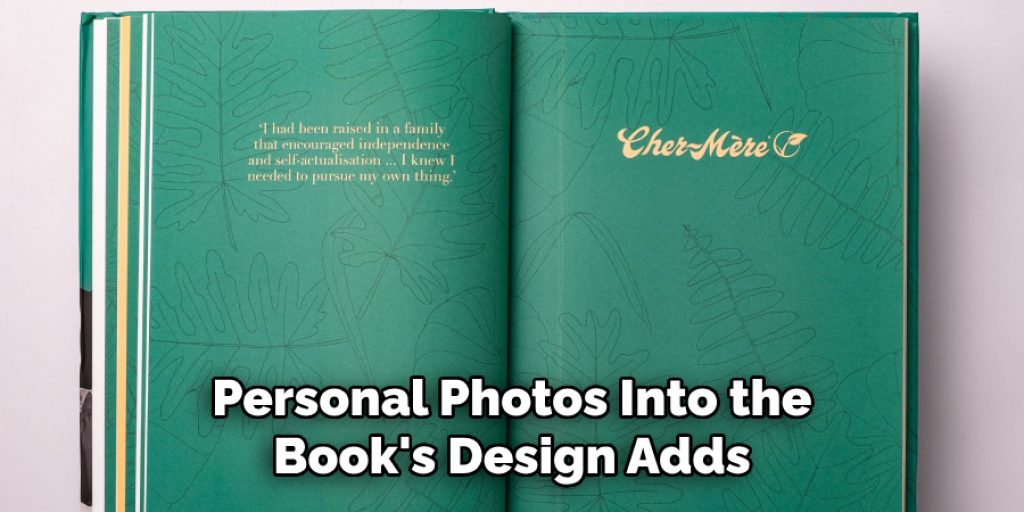
This could be done through decoupage, where you layer images and text on the cover, or by creating custom jackets for your books that feature these personal elements. Select quotes that inspire you or images that evoke cherished memories, transforming your decor books into repositories of personal lore and motivation.
C. Customizing Books to Match Specific Themes or Color Schemes
Aligning your decor books with your home’s aesthetic theme or color scheme ensures they complement your space’s overall design. Consider the subject or era the books might represent for thematic consistency and use design elements that align with this theme. For example, books in a maritime-themed room might feature covers in shades of blue, adorned with nautical decor like anchors or ship wheels.
To customize books to fit a specific color scheme, select or create covers in the desired hues, ensuring they harmonize or provide an appealing contrast with their surroundings. This approach elevates your home decor and turns your books into integral elements of your interior design.
Through the addition of monograms, meaningful quotes or images, and thematic customization, decor books transcend their traditional roles. They become personalized artifacts that reflect and enhance the homeowner’s personality, interests, and aesthetic preferences. This level of customization enriches the home’s storytelling, making each decor book a testament to the owner’s creativity and the stories that shape their life.
Exploring Alternative Uses for Decor Books
Decor books need not be relegated to merely sitting on a shelf; they can serve multiple purposes, acting as both aesthetic and functional pieces within a home. By exploring alternative uses, one can further integrate books into the overall decor, making them items of intellectual charm and practical utility.
A. Displaying Books as Standalone Decor Pieces
Books, especially those with visually striking covers or spines, can be displayed as standalone decor items. Arranged on coffee tables, mantels, or even wall-mounted shelves, they can function as focal points that draw attention and spark conversations.

For instance, a beautifully bound vintage book or an artistically illustrated modern edition can stand on an easel, serving as an intriguing piece of art in its own right. This approach highlights the individual beauty of each book and allows for flexible, easily changeable decor.
B. Incorporating Books into Shelving Arrangements
Beyond their traditional row alignment on shelves, books can be arranged in various creative ways to enhance the visual appeal of a room. Stacking books horizontally can create platforms for displaying other decorative items like vases, candles, or small sculptures.
Alternatively, playing with the alignment and spacing of books, such as arranging them in a zigzag pattern or grouping them by color, can add rhythm and interest to shelving displays. This method blends the books seamlessly into the decor, making the shelving unit itself a piece of visual interest.
C. Using Books as Functional Decor, Such as Storage Containers
Decor books can also be repurposed into functional decor items, such as storage containers for small items. By hollowing out the interior of a book, one can create a secret storage space that blends inconspicuously with the rest of the bookshelf. This is not only a clever way to hide valuables or clutter but also adds an element of surprise and creativity to the decor.
For a more open storage solution, larger books can be glued together and trimmed to serve as an original magazine rack or remote control holder, combining utility with the charming aesthetic of bound literature.
Exploring alternative uses for decor books broadens their role in home decor, transforming them from mere reading material or aesthetic objects into versatile elements that contribute beauty and functionality to living spaces. Whether displayed as unique decor pieces, creatively arranged on shelves, or repurposed for storage, decor books offer endless possibilities for enhancing personal and artistic expression within a home.
Preservation and Care Tips
Ensuring that your decorated books remain in pristine condition over time requires attention to preservation and care. By adopting specific measures, you can protect these treasured decor items from wear and tear, maintaining their beauty and integrity for years to come.
A. Protecting Decorated Books from Wear and Tear
To safeguard decorated books, consider applying a clear, protective cover or sealant over their covers, especially if they are frequently handled or displayed where they might be exposed to sunlight. This can prevent fading, staining, and physical damage like scratches or dents. For books with delicate decorations such as gold leaf or raised features, it’s advisable to display them in areas with minimal direct contact to protect their intricate designs.
B. Storing Books Properly to Maintain Their Condition
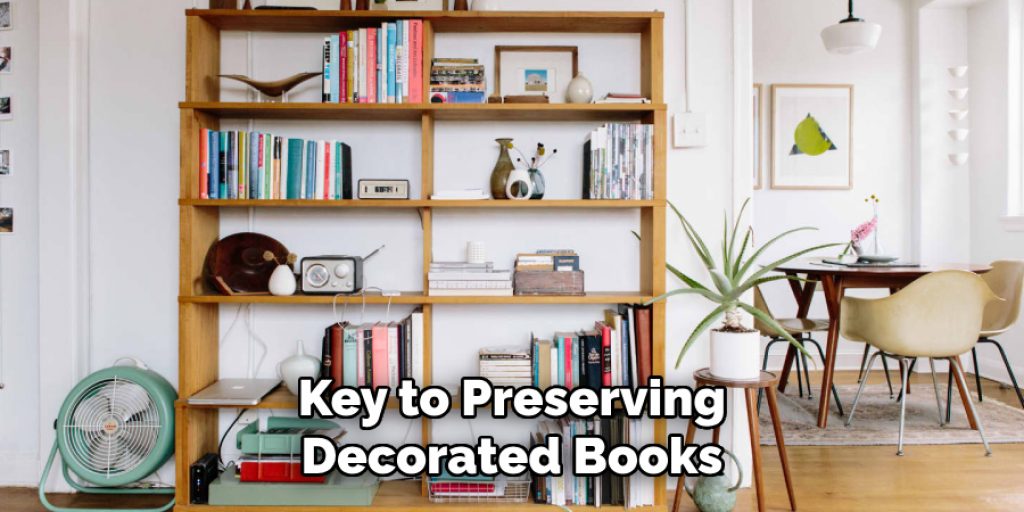
Proper storage is key to preserving decorated books. Avoid placing them in damp areas or near heat sources, as moisture and temperature fluctuations can cause warping, mold, or discoloration. Books should be stored upright with adequate support to prevent them from slumping or warping. If space allows, storing them behind glass doors can further protect them from dust and environmental damage.
C. Cleaning and Dusting Decorated Books
Regular dusting of decorated books prevents buildup that could potentially harm their surfaces or pages. Use a soft, dry cloth or a gentle brush to dust the covers and spines. Compressed air cans used at a safe distance can remove dust without direct contact with more intricate or fragile decorations. If a book becomes soiled, consult a conservation professional before using any cleaning agents, as these could damage delicate decorations or finishes.
Adhering to these preservation and care tips can significantly extend the life and beauty of your decorated books, ensuring they continue to be cherished components of your home decor. Whether showcased on a mantle, arranged on shelving, or repurposed as functional decor, properly cared-for books retain their allure and historical value, enriching your living spaces with their stories and aesthetics.
Conclusion: Embracing Creativity in Decor
Throughout this exploration of how to make decor books a unique and integral part of home aesthetics, we’ve traversed from the storytelling power of book décor to the innovative alternative uses that blend both form and function. The DIY decor book techniques discussed not only showcase the potential of books to serve as foundational elements of style but also highlight the importance of personal touch and creativity in elevating the home environment.
Encouragement to experiment and personalize cannot be overstated. The techniques presented are merely a starting point. The real beauty and charm of decor books come alive when you infuse them with your own stories, tastes, and creativity. Whether it’s by choosing books that resonate with your personal history or by physically crafting books into objects of beauty and utility, each step in the process is an opportunity to imprint your character and vision onto your space.
The aesthetic and functional value of decor books is unquestionable. Beyond their traditional role as vessels of knowledge, books open up a world of possibilities when seen through the lens of decor. They become artifacts of distinction, conversation starters, and silent narrators of the homeowner’s journeys and tastes.
This guide on making decor books a part of your home decor is not just about beautification; it’s a call to view books as versatile companions in crafting living spaces that reflect and accommodate the complexities and nuances of life.
In essence, the world of decor books is an invitation to blend the rich realms of literature and interior design, a challenge to redefine spaces with imagination and flair. It’s a testament to the boundless potential housed within the pages of books, waiting to be unlocked and shared in the most visually compelling ways.




